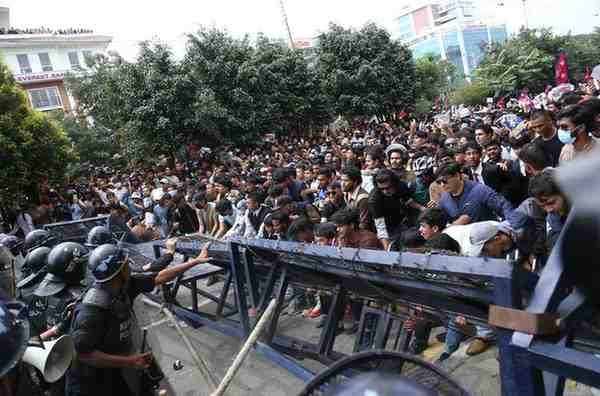Kathmandu witnessed one of its most turbulent days in recent history on Tuesday as Prime Minister KP Sharma Oli stepped down following two consecutive days of violent anti-corruption protests.
The unrest, largely driven by Gen Z demonstrators angered by corruption scandals and recent government policies, escalated into chaos across the capital, forcing authorities to impose curfews, shut down the country’s only international airport, and put India-Nepal border security on high alert.
Oli Steps Down Amid Mounting Pressure
In a televised statement, Oli announced his resignation, saying he was stepping aside “to facilitate a political solution to the problem” and allow the country to move forward. The decision came hours after widespread violence engulfed Kathmandu and surrounding areas, with protesters targeting government buildings and residences of top political leaders.
News agencies reported that Oli’s home in Balkot, as well as those of President Ram Chandra Poudel and Home Minister Ramesh Lekhak, were set ablaze.
The resignation followed an emergency all-party meeting convened by Oli earlier in the day, which failed to calm the situation. Crowds had already stormed and torched the central office of the Nepali Congress in Lalitpur, intensifying political tensions.
Airports Shut, Fears of Flight
The violence spilled into the aviation sector as Tribhuvan International Airport (TIA) in Kathmandu, the country’s sole international air hub, was forced to close operations indefinitely.
The Kathmandu Post reported that authorities cited “serious and unprecedented security concerns” as the reason behind the closure.
The closure also sparked rumors that senior ministers, including Oli, were attempting to flee the country, although no confirmation was provided. Indian airlines IndiGo and Air India suspended their Kathmandu operations following the airport shutdown.
Assaults on Top Leaders
The protests turned personal and violent against political leaders. Former Prime Minister and Nepali Congress president Sher Bahadur Deuba, along with his wife Arzu Rana Deuba—Nepal’s sitting Foreign Minister—were allegedly attacked at their Budanilkantha residence.
Videos circulating online appeared to show Deuba bleeding from his face while protesters vandalized their home. Reports indicated the couple had been held in “custody” by demonstrators.
The violence did not stop there. Bishnu Prasad Paudel, Deputy Prime Minister and Finance Minister, was beaten and stripped by protesters, according to local media.
Graphic videos purportedly from the scene showed him being dragged by his arms and legs. Paudel, who also serves as vice chairman of Oli’s Communist Party of Nepal (Unified Marxist–Leninist), was among several senior politicians directly targeted. Former minister Ek Nath Dhakal was also reportedly stripped and paraded by crowds.
Roots of the Agitation
The current wave of protests erupted after the government recently revoked a controversial ban on social media platforms. The ban, widely criticized as an attack on free speech, had triggered large-scale mobilization by young protesters. On Monday, confrontations between demonstrators and security forces left at least 19 people dead and more than 400 injured.
Anger quickly shifted to long-standing grievances over corruption and alleged misuse of power by political elites. Demonstrators accused leaders across party lines of failing to address unemployment, inflation, and governance failures, instead prioritizing their personal and party interests.
Curfew and Cross-Border Alarm
With the capital under siege, the Kathmandu District Administration Office declared a curfew starting Tuesday morning, banning public movement until further notice. Authorities said the measures were necessary to prevent further violence and loss of life.
The turmoil in Nepal also raised concerns across the border in India. New Delhi issued an advisory urging Indian nationals living in Nepal to remain cautious and follow local security guidelines. Security was tightened along the 1,751-kilometer-long India-Nepal frontier, with paramilitary forces on alert to prevent any spillover of unrest.
Mayor’s Appeal to Protesters
Amid the chaos, Kathmandu Metropolitan City Mayor Balendra Shah appealed directly to the young demonstrators to show restraint following Oli’s resignation. In a Facebook post, Shah reminded protesters that public and private properties were national resources and their destruction amounted to self-inflicted loss.
“Please remain calm. The loss of national resources is our collective loss,” Shah wrote. “It is now necessary for all of us to show restraint. From here onwards, it is your generation that must lead the country.”
His appeal, however, did little to cool tempers on the ground, as reports of arson, vandalism, and attacks on politicians continued into the evening.
A Nation at a Crossroads
The resignation of KP Sharma Oli marks a dramatic turn in Nepal’s political journey, which has been marred by frequent changes of government since the country abolished its monarchy in 2008. Oli himself has held office three times, often navigating bitter rivalries within and outside his Communist Party.
Analysts say the immediate challenge lies in containing the protests and preventing a complete collapse of law and order. The detention and assault of senior leaders, including a former prime minister and the sitting foreign minister, reflect a dangerous breakdown of institutional respect.
For now, questions loom over who will take charge in the interim. Former Prime Minister Sher Bahadur Deuba’s Nepali Congress remains in the ruling coalition but faces deep hostility from protesters, leaving no clear political alternative. Deputy Prime Minister Paudel’s assault further weakens the Communist Party’s ability to project leadership.
As Nepal grapples with this political vacuum, the role of the younger generation—particularly Gen Z protesters—may become decisive in shaping the country’s direction. But whether their anger translates into constructive political participation or further instability remains uncertain.
Regional Implications
Nepal’s crisis also has wider implications for South Asia, where stability in the Himalayan nation is closely tied to security and trade. India, already on alert, is likely to watch closely how events unfold, given Kathmandu’s strategic importance between India and China.
For ordinary Nepalis, however, the immediate concern remains safety and stability. With the capital under curfew, flights grounded, and political leaders under attack, the nation faces a critical test of resilience in the days ahead.








